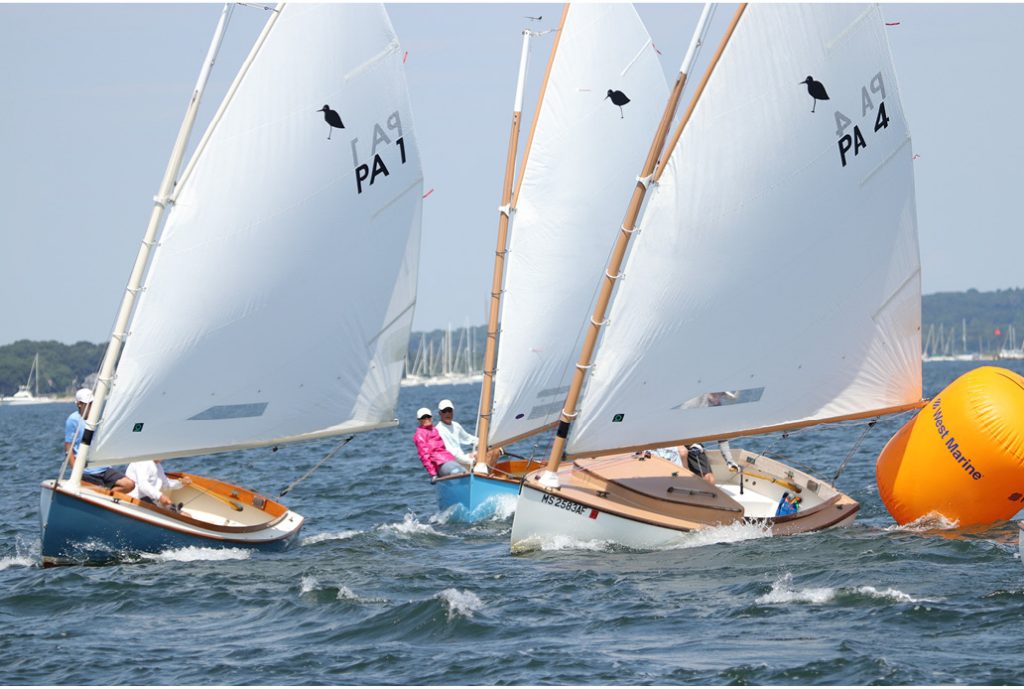When it comes to other boats, your biggest tactical problem is usually the wind shadows they create. While it’s true that you sometimes have to change your course to avoid hitting your competitors or to give them right of way, these problems are generally not as significant as the widespread effects of bad air.
In a big fleet it’s not uncommon to sail in disturbed air for at least part of each upwind leg, especially the first one where boats are usually bunched quite close together. But whenever you’re affected by another boat’s wind shadow, you can be sure you’re going slower than, and losing ground to, many other boats.
The existence of wind shadows on a beat is one obvious reason why the leaders keep getting farther ahead and the tailenders farther behind. So one of your main tactical challenges on any beat is figuring out how to keep your air clear as long as possible. Here are some ideas on how to do this:
• Know the location of bad air. If you want to avoid wind shadows, you must first know where they are. Remember that dirty air extends to leeward of a boat in the direction opposite to her apparent wind.
• How bad is bad air? Your tactics should take into account the relative importance of avoiding bad air. For example, in light wind it’s usually very slow to sit in another boat’s wind shadow. When someone tacks on your breeze, you must almost always do something to clear your air, even if this means putting your strategic plan on hold. But in heavy air, bad air is much less harmful, so you might decide to keep sailing in a boat’s dirty air.
• How valuable is clear air? Your tactical plan should also reflect the ease or difficulty of finding clear air. In a large fleet it can be very difficult to avoid other boats’ dirty air, especially on the first beat. Therefore, it might be worth doing almost anything to find your own lane of clear air – even sailing toward the unfavored side! In a small fleet, however, clear air is easy to find. So make sure that you are in clear air almost all the time, and don’t be willing to give up very much (e.g. sail in the wrong direction) in order to find clear air.

It’s usually not a great idea to get to the layline first because boats that are ahead of you will then be able to tack on your wind. Therefore, before you reach the layline, take a look at the boats to windward. © Spectrum Photo/Fran Grenon
• Steer clear of your competitors. When you’re trying to sail fast with clear air, it’s almost always better to keep away from other boats if possible. Every boat leaves behind an area of disturbed wind and water that will make you go slower. It’s not always easy to avoid this, but here are some things to try:
Look to windward and ahead for “lanes” or “zones” of clear air. Try to anticipate how you can position yourself in these areas of fewer boats where you will have a better chance of avoiding bad air.
Sometimes you must be willing to compromise a bit on your strategic plan in order to keep sailing fast.
Don’t make a habit of tacking on other boats, and they will tend to leave you alone as well.
Avoid putting yourself in positions (e.g. on the layline) where boats ahead of you are likely to tack.
Wave a port tacker across. When you’re in a good lane on starboard tack, it’s better to duck a port tacker than to have her lee-bow you.
• Use other boats to help you. There are a few times when the presence of other boats can actually help you maintain clear air.
When you’re on starboard tack, use a ‘blocker’ on your leeward side to keep port tackers from tacking on your lee bow.
When you’re in a good lane on port tack and you’re almost crossing a starboard tacker, ask them if you can cross. This is often a better way to keep clear air than tacking or making a big duck. Put yourself in a ‘safe leeward’ position on other boats. You’ll get a lift and more pressure as the wind bends around the front of their sailplan. ■
This article originally appeared in David Dellenbaugh’s Speed & Smarts, The newsletter of how-to tips for racing sailors. If you want to sail faster and smarter, log onto SpeedandSmarts.com.
A resident of Easton, CT, Dellenbaugh was tactician and starting helmsman for America3’s successful defense of the America’s Cup in 1992. He’s a Lightning World Champion, two-time Congressional Cup winner, seven-time Thistle National Champion, two-time winner of the Canada’s Cup, three-time Prince of Wales U.S. Match Racing Champion, and a winner of the U.S. Team Racing Championships for the Hinman Trophy.



